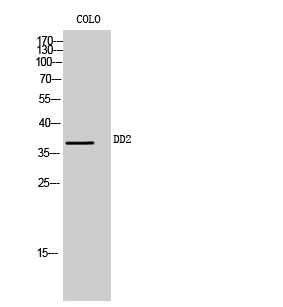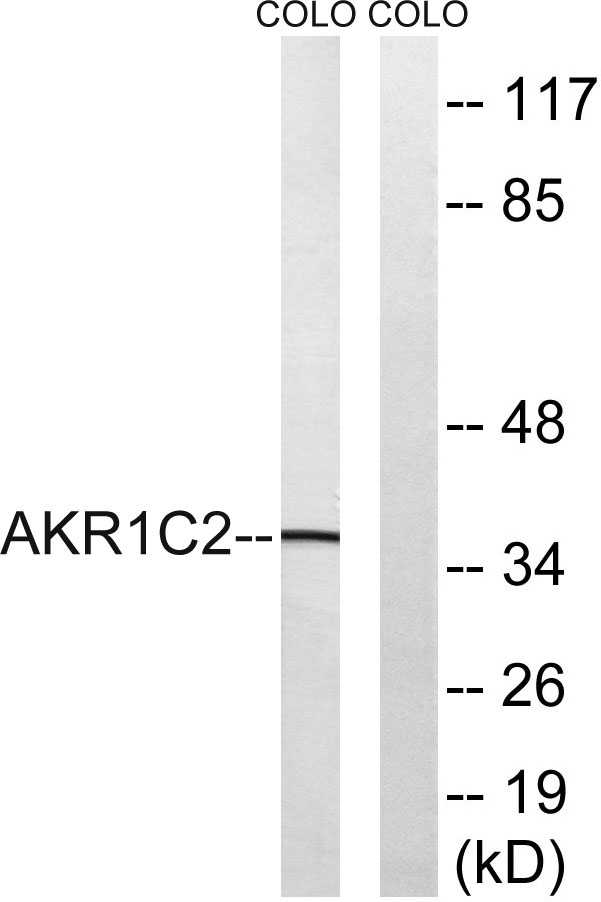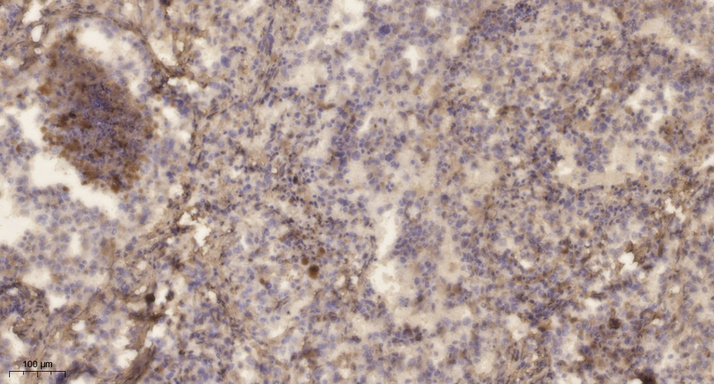DD2 Polyclonal Antibody
- Catalog No.:YT1305
- Applications:WB;IHC;IF;ELISA
- Reactivity:Human;Rat;Mouse;
- Target:
- DD2
- Fields:
- >>Steroid hormone biosynthesis;>>Chemical carcinogenesis - DNA adducts;>>Chemical carcinogenesis - reactive oxygen species
- Gene Name:
- AKR1C2
- Protein Name:
- Aldo-keto reductase family 1 member C2
- Human Gene Id:
- 1646
- Human Swiss Prot No:
- P52895
- Immunogen:
- The antiserum was produced against synthesized peptide derived from human AKR1C2. AA range:21-70
- Specificity:
- DD2 Polyclonal Antibody detects endogenous levels of DD2 protein.
- Formulation:
- Liquid in PBS containing 50% glycerol, 0.5% BSA and 0.02% sodium azide.
- Source:
- Polyclonal, Rabbit,IgG
- Dilution:
- WB 1:500 - 1:2000. IHC 1:100 - 1:300. ELISA: 1:20000.. IF 1:50-200
- Purification:
- The antibody was affinity-purified from rabbit antiserum by affinity-chromatography using epitope-specific immunogen.
- Concentration:
- 1 mg/ml
- Storage Stability:
- -15°C to -25°C/1 year(Do not lower than -25°C)
- Other Name:
- AKR1C2;DDH2;Aldo-keto reductase family 1 member C2;3-alpha-HSD3;Chlordecone reductase homolog HAKRD;Dihydrodiol dehydrogenase 2;DD-2;DD2;Dihydrodiol dehydrogenase/bile acid-binding protein;DD/BABP;Trans-1;2-dihydrobenzene-1,2-diol
- Observed Band(KD):
- 37kD
- Background:
- This gene encodes a member of the aldo/keto reductase superfamily, which consists of more than 40 known enzymes and proteins. These enzymes catalyze the conversion of aldehydes and ketones to their corresponding alcohols using NADH and/or NADPH as cofactors. The enzymes display overlapping but distinct substrate specificity. This enzyme binds bile acid with high affinity, and shows minimal 3-alpha-hydroxysteroid dehydrogenase activity. This gene shares high sequence identity with three other gene members and is clustered with those three genes at chromosome 10p15-p14. Three transcript variants encoding two different isoforms have been found for this gene. [provided by RefSeq, Dec 2011],
- Function:
- catalytic activity:Androsterone + NAD(P)(+) = 5-alpha-androstane-3,17-dione + NAD(P)H.,catalytic activity:Trans-1,2-dihydrobenzene-1,2-diol + NADP(+) = catechol + NADPH.,enzyme regulation:Inhibited by hexestrol with an IC(50) of 2.8 uM, 1,10-phenanthroline with an IC(50) of 2100 uM, 1,7-phenanthroline with an IC(50) of 1500 uM, flufenamic acid with an IC(50) of 0.9 uM, indomethacin with an IC(50) of 75 uM, ibuprofen with an IC(50) of 6.9 uM, lithocholic acid with an IC(50) of 0.07 uM, ursodeoxycholic acid with an IC(50) of 0.08 uM and chenodeoxycholic acid with an IC(50) of 0.13 uM.,function:Works in concert with the 5-alpha/5-beta-steroid reductases to convert steroid hormones into the 3-alpha/5-alpha and 3-alpha/5-beta-tetrahydrosteroids. Catalyzes the inactivation of the most potent androgen 5-alpha-dihydrotestosterone (5-alpha-DHT) to 5-alpha-androstane-3-alpha,17-beta-diol (3-alpha-
- Subcellular Location:
- Cytoplasm, cytosol .
- Expression:
- Expressed in fetal testes. Expressed in fetal and adult adrenal glands.
- June 19-2018
- WESTERN IMMUNOBLOTTING PROTOCOL
- June 19-2018
- IMMUNOHISTOCHEMISTRY-PARAFFIN PROTOCOL
- June 19-2018
- IMMUNOFLUORESCENCE PROTOCOL
- September 08-2020
- FLOW-CYTOMEYRT-PROTOCOL
- May 20-2022
- Cell-Based ELISA│解您多样本WB检测之困扰
- July 13-2018
- CELL-BASED-ELISA-PROTOCOL-FOR-ACETYL-PROTEIN
- July 13-2018
- CELL-BASED-ELISA-PROTOCOL-FOR-PHOSPHO-PROTEIN
- July 13-2018
- Antibody-FAQs
- Products Images

- Western Blot analysis of COLO cells using DD2 Polyclonal Antibody

- Western blot analysis of lysates from COLO cells, using AKR1C2 Antibody. The lane on the right is blocked with the synthesized peptide.

- Immunohistochemical analysis of paraffin-embedded human lung cancer. 1, Antibody was diluted at 1:200(4° overnight). 2, Tris-EDTA,pH9.0 was used for antigen retrieval. 3,Secondary antibody was diluted at 1:200(room temperature, 45min).



